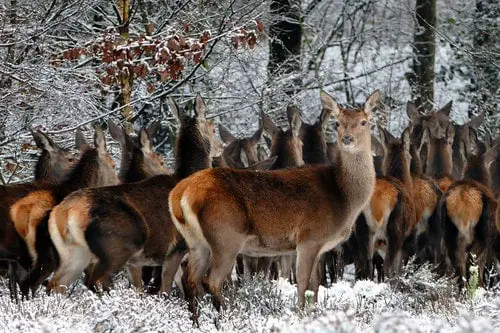Deers are incredible animals that can survive in all weather conditions including winter even if it is a very harsh one. This mysterious reality is not unknown to most hunters who hunt for deers. Many are very curious just like you to know how deers stay warm and what makes them survive in this kind of terrible weather.
In this article, you will see the beautiful and remarkable features that have been given to them by nature which is why they are called the Kings of the winter.
A deer is a hoofed, four-legged, and herbivorous animal with antlers. The antlers of the male deer which is known as the buck are bigger than that of the female deer which is called a doe. Deers can be found in many different environments such as mountains, grasslands, rain forests, wetlands, arid scrublands, and deciduous forests.

Nature has so much blessed them with both physical and behavioral adaptations that make them survive the harshest season or weather. let’s take a look at some of them.
Physical And Behavioral Adaptations That Help Deers Stay Warm
Unusual And Uncommon Fur
A fur is the hairy coat of various mammals species. The kind of fur that is in a deer is different from that of other animals in the animal kingdom. The fur in a deer’s winter coat is so unique and special that it has a hollow that gives it the power to arrest air. This trapped air allows the deer to sustain its heat easily without stress. A deer’s skin generates a natural oil from the oil-producing gland so as to make its fur to be waterproof.
A deer’s winter coat has more benefits to the deer in the period of winter:
- It helps them to absorb sufficient sunlight.
- It keeps them warm even when the temperature is -30 degrees Fahrenheit.
- It serves as a lasting insulator to the deer.
- It protects the deer from the cold hands of the cold.
During the fall season, the deer replaces their summer hair coat for a winter hair coat. This helps them fight the winter when it comes. They are always prepared ahead of time. This winter hair coat is thicker, longer, and darker than the summer one.
Slowdown Attitude
Deers are very well known for their agility but during the winter they are very smart by reducing their activeness which in turn reduces their metabolism. This habit makes them consume less food and it gives them the privilege to reserve their energy; this behavioral attitude makes them very distinct from other animals.
Storing Fats
Deers are one of the animals on this green planet that is very calculative: Right before the winter arrives with its craziness, the deer’s body begins to store up extra fats around their internal organs and under their skin so as to provide it with insulation and also give it the power and energy to survive the harsh weather.

Foods are very scarce and hard to come by during the regime of the winter. This is why the deer build a huge factory in itself to store fats that will help it to survive the scarcity of food during the winter. Fats are the most essential survival element of every deer that wants to see the end of the winter season.
Unusual Consumption of Food
Once the winter hits hard and comes with a scarcity of foods, the deer begin to feed on anything that is available in their environment. They can feed on twigs, grasses, tree barks, berries, holly, nuts, rhododendron, yews, arborvitae, etc. They do all this just to stay alive and live longer to succeed in the cold season.
Amazing Source Of Water
You may wonder as many do at the way deer find water to quench their thirst during the cold season when we already have frozen water. Deer have three super ways of satisfying their burning desire whenever they are thirsty. I guess nature has blessed them beyond imagination:
- Deer get water from the moisture present in the food they consume.
- Deer also get water through the process of food digestion.
- They also get water through the metabolic water that is discharged from the food.
According to studies, it is well observed that deer especially the northern ones have the special, and unusual ability to reuse their urine whenever they are in need of water during the cold season.
Smart Shelter
During the winter season, deer take shields from evergreen trees such as hemlocks, cedars, spruces, pines, etc. This kind of gathering is called “yarding up”. The canopy of these trees helps the deer to reduce the speed of the wind and snowpack and thereby making it easier for them to keep warm.

This gives them enough opportunity to leverage on the less speed of the wind and the reduced snowpack. All this helps them not to waste too much energy.
Deer Watch Over deer
It has become a custom or ritual of groups of deer that pack themselves together to look after one another [1]; they give solid protection to each other. When they gather like that, they all look in different directions for hungry predators. Whenever a predator is sighted, they have a special and unique way of giving a warning signal to each other.
Survival In Freezing Water
Deer so much have survival features that freezing water can’t give it a red light. They are very good at swimming as if they learned it from fishes when it comes to scaling through freezing water. They can swim to the other side of the water without having an abnormality in their temperature; freezing water is no match to them at all as long as the water or river is free from ice.
Increase In Size
The increase in the size of Northern deer serves as a huge benefit to them as it contributes to their survival in the winter. The enlargement in size helps the deer to generate sufficient heat conveniently and efficiently and also helps it to sustain the provided heat.
Deer are some of the animals that stay active throughout the day, especially during sunrise and dusk. I’m sure that when next you see a deer in winter, you will remember what makes them survive in that kind of weather.
Glossary
- The Berkshire Eagle [Link]




